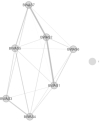Work addiction in Chinese white-collar workers: the psychometric properties of its measure and its comorbidity with general anxiety in network analysis
- PMID: 37491337
- PMCID: PMC10369739
- DOI: 10.1186/s40359-023-01247-7
Work addiction in Chinese white-collar workers: the psychometric properties of its measure and its comorbidity with general anxiety in network analysis
Abstract
Background: Work addiction (WA) threatens occupation-related health in many countries including China. This research aims to evaluate the psychometric properties of the Chinese version of Bergen Work Addiction Scale (BWAS), the most common measure of WA, to facilitate relevant studies in Chinese workers. A network analysis was further conducted to identify central and bridge symptoms within the WA-anxiety network to improve intervention practices.
Methods: A total of 694 Chinese white-collar workers completed an online questionnaire survey in March of 2022, and the responses to BWAS from a subsample of 50 participants one month after this survey were also collected.
Results: The unidimensionality of BWAS was supported by results of exploratory factor analysis, exploratory graph analysis, and confirmatory factor analysis and we found satisfactory internal consistency and acceptable test-retest reliability. Multiple-group factor analyses confirmed the measurement invariance of BWAS across genders, districts (i.e., central China, eastern China, western China, and northeastern China), and age groups (i.e., young and middle-aged adults) while the convergent validity of BWAS was demonstrated by its significant correlations with Dutch Work Addiction Scale (r = 0.62, p < 0.001) and its criterion validity was indicated by its significant correlations with general anxiety, weekly work hours, and health status (r = -0.16 to 0.31, p < 0.001-0.01). Network analysis further revealed two central symptoms (WA-tolerance and WA-problems) and three bridge symptoms (WA-problems, WA-mood modification, and mouth dryness of general anxiety) maintaining the WA-anxiety comorbidity.
Conclusions: Our findings suggest that BWAS is a valid measure of WA in Chinese workers and interventions should put special attention to the identified central and bridge symptoms underlying the WA-anxiety network.
Keywords: Anxiety; Bergen Work Addiction Scale; Network analysis; Psychometric properties; Work addiction; Workaholism.
© 2023. The Author(s).
Conflict of interest statement
The authors declare that they have no competing interests.
Figures





Similar articles
-
Validity and reliability of a Chinese version of the Bergen Work Addiction Scale.Front Psychol. 2023 May 2;14:1029846. doi: 10.3389/fpsyg.2023.1029846. eCollection 2023. Front Psychol. 2023. PMID: 37205064 Free PMC article.
-
Psychometric evaluation of the Chinese version of social anxiety scale for social media users and cross-sectional investigation into this disorder among college students.Compr Psychiatry. 2022 Jul;116:152328. doi: 10.1016/j.comppsych.2022.152328. Epub 2022 May 21. Compr Psychiatry. 2022. PMID: 35623103
-
Factor structure and psychometric properties of the Chinese version of the 20-item Pain Anxiety Symptoms Scale (ChPASS-20).J Pain Symptom Manage. 2012 Jun;43(6):1131-40. doi: 10.1016/j.jpainsymman.2011.06.021. J Pain Symptom Manage. 2012. PMID: 22651953
-
The Chinese version of the Perceived Stress Questionnaire: development and validation amongst medical students and workers.Health Qual Life Outcomes. 2020 Mar 13;18(1):70. doi: 10.1186/s12955-020-01307-1. Health Qual Life Outcomes. 2020. PMID: 32169070 Free PMC article.
-
Psychometric properties of the Anxiety Inventory for Respiratory Disease in patients with COPD in China.Int J Chron Obstruct Pulmon Dis. 2016 Dec 20;12:49-58. doi: 10.2147/COPD.S117626. eCollection 2017. Int J Chron Obstruct Pulmon Dis. 2016. PMID: 28053516 Free PMC article.
References
-
- Subramanian K. Workaholism—Does working more impact productivity. Int J Innovative Trends Eng. 2018;62(40):69–75.
-
- Griffiths MD. Workaholism—A 21st-century addiction. The Psychologist. 2011;24(10):740–4.
MeSH terms
Grants and funding
LinkOut - more resources
Full Text Sources
Medical

